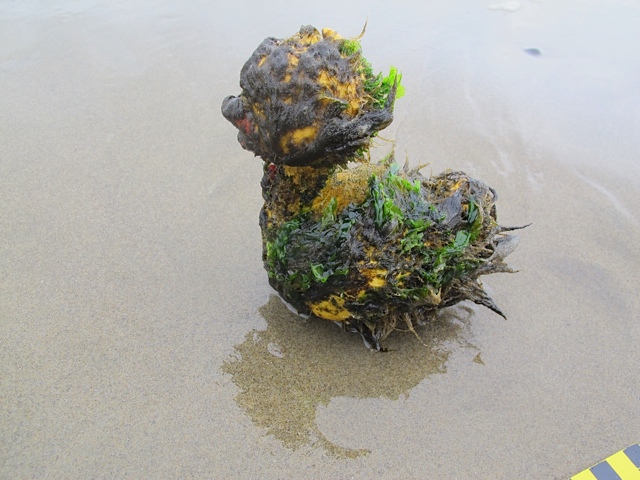Over spring break, marine debris student intern, Abby, spent the day hunting for petroglyphs and marine debris on the three-mile stretch of beach from Cape Alava to Sand Point.
By far the most interesting find was a weathered blue plastic duck, found among some seaweed in the wrack, with a large sharpie-marked “#245” on the bottom of it. Abby guessed it might have been a part of some project, so she brought it back to the COASST office to investigate.

Was #245 its race number and this guy made it a lot farther than the finish line?
Curtis Ebbesmeyer, a local oceanographer whose work revolves around modeling ocean currents, popularized the use of marine debris as a type of tracking movement of water on the ocean surface. He got his start after a large shipment of 29,000 plastic “Friendly Floatees” bath toys were dumped into the Pacific Ocean in 1992 and for the next 15 years or so people were finding toys from this specific spill washing up on beaches all over the world.

Photo credit A. Larson. Another example of a beached duck, but you won’t find this guy in the COASST field guide!
Picking up on this idea, schools, cities, and various non-profit organizations have taken to releasing batches of rubber ducks into streams and oceans, and relying on helpful beachcombers to report where and when they’re found. While COASST won’t be releasing any ducks or wood blocks (the slightly more eco-friendly version), future marine debris participants will collect information on where and when an object was found, material size, markings and identity to provide insight into source and movement patterns for all debris.
As to the little blue duck? After some CSI sleuthing on Google we found a “vintage” duck of the same style for sale on Etsy. Heidi did mention the Annual Great Olympic Peninsula Duck Derby, a good and local contender, but recent releases feature classic, yellow ducks. Finally, a potential match – could it be from the San Clemente (CA) Ocean Festival, about 1,740 kilometers south of the spot Abby found it on the North Coast of Washington?




